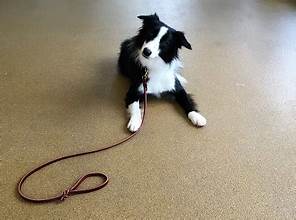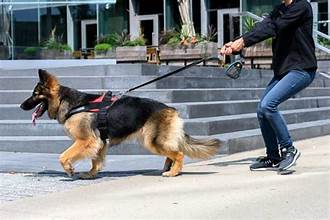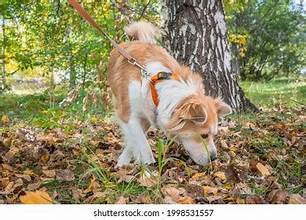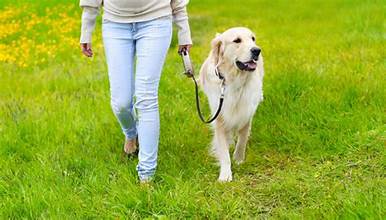Imagine the joy of you and your furry friend strolling side-by-side in the park.
Birds sing, squirrels play, and your dog walks happily on a loose leash. This delightful scene is a dream and a goal that leash training can help you achieve.
Let’s face it:
The early stages of leash training can feel more like a battle than a leisurely walk. But fear not!
You can turn your leash-resistant pup into a walking champion with patience, positive reinforcement, and the proper techniques.

Setting the Stage for Success
Before you clip on the leash and head out the door, remember these key things are crucial for your dog’s safety and your peace of mind:
Get the right equipment:
A comfortable harness is a lifesaver, especially for pulling dogs. A properly fitted harness distributes pressure evenly, making walks more enjoyable for both of you.
Opt for a leash with a comfortable grip, giving you a sense of control and security. Avoid retractable leashes for training purposes (they can encourage pulling). A shorter leash (4-6 feet) offers better control during training.

Start small:
Remember, you’re not in a rush. Don’t overwhelm your dog. Begin leash training indoors in a quiet, distraction-free area. This gradual approach will make the process more manageable for you and your furry friend.

Short and Sweet:
Remember, consistency is critical. Keep training sessions short and engaging. This approach will keep you and your pup motivated and committed to the training process.
Positive reinforcement is critical:
Reward good behavior with treats, praise, or a happy voice. Stock up on high-value treats (tiny bits of meat, cheese, etc.) that your dog will go crazy for. Reward them for calm behavior on the leash, not pulling.

Let’s Get Leashing!
Make the Leash Fun:
Before attaching the leash, let your dog sniff and get comfortable with it. Let your dog wear the leash around the house while playing or relaxing. Play with the leash as a toy, and reward your dog with treats when it interacts positively.
The Power of Treats:
Hold a high-value treat near your dog’s nose and slowly lure them to walk beside you. Reward them with the treat when they’re walking with a loose leash.

Inside practice:
Attach the leash and reward your dog for wearing it. Then, lure the dog to walk beside you with treats, rewarding it when the leash is slack.
Uh Oh, Pulling?
If your dog pulls, stop walking. Stand still and wait for them to return to your side with a loose leash. Once they do, reward them and resume walking.
Change Direction:
Practice changing directions frequently to keep your dog focused on you and walking by your side.
Gradual Progression:
Once your dog has mastered walking on a loose leash indoors, gradually introduce distractions and move your training sessions outdoors.
Patience and consistency:
Leash training takes time. Give your dog time and consistent training methods. Short training sessions are more effective than long, frustrating ones.
Pro Tips for a Smooth Walk
Stay calm and assertive:
Your energy transmits to your dog. Avoid getting frustrated or yanking on the leash.
Make walks fun!
Let your dog sniff and explore at appropriate times during your walk. This mental stimulation will help them stay focused.
Practice, practice, practice:
The more you practice leash training, the more ingrained good walking manners will become.
Taking it Outside (Gradually)
Once your dog has mastered the basics indoors, it’s time to transition to quieter outdoor areas gradually. Remember, patience is critical, as the world outside is full of exciting distractions!
Keep Walks Short and Sweet:
Start with short training sessions to avoid overwhelming your dog. Gradually increase the duration as they progress.

Reward Loose Leash Walking
The key is rewarding only when the leash is slack. It will teach your dog that pulling tightens the leash, and a loose leash earns them yummy treats.
Stay Calm and Consistent
Expect setbacks and avoid getting frustrated. Consistency is key! Give positive reinforcements, such as treats and praise, for good behavior.
Pro Tips for Common Challenges:
Pulling
Stop walking when your dog pulls. Wait for your dog to return to your side with a loose leash before continuing.

Sniffing:
Allow your dog to sniff and explore briefly, but gently redirect them to your side with a treat or gentle tug on the leash.

Reactivity
If your dog barks or lunges at other dogs or stimuli, remember that professional trainers are there to guide you with desensitization and counterconditioning techniques. Seek their help for a more confident and successful dog-walking experience.
Remember, a well-trained leash walker is a happy walker!
With patience, positive reinforcement, and these helpful tips, you and your dog will soon enjoy peaceful strolls together.
Leash training takes time, patience, and consistency.
But with these tips and a positive approach, you’ll be well on your way to enjoying relaxed and rewarding walks with your canine companion!



